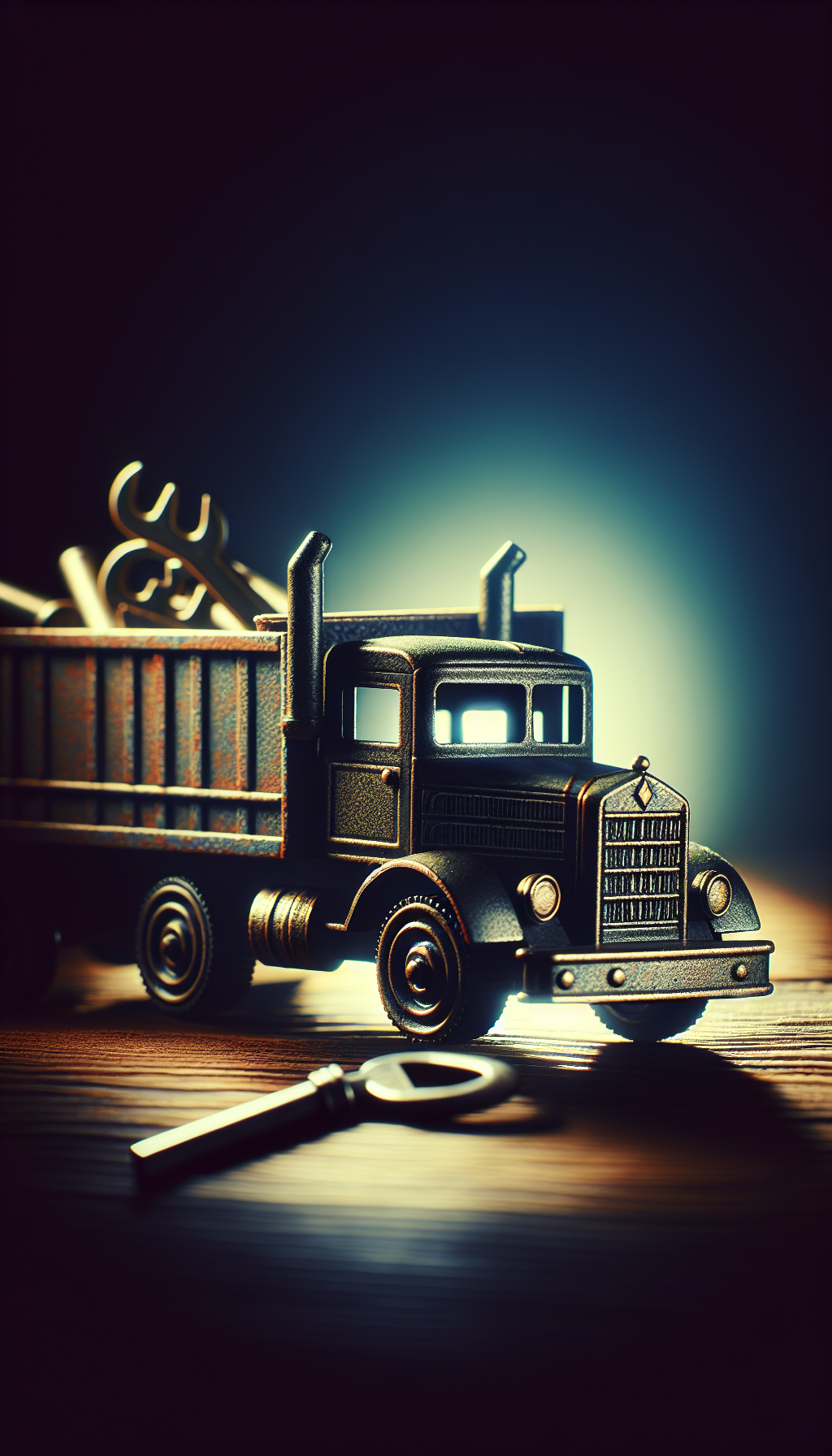Unlocking The Treasure Trove The Surprising Value Of Vintage Metal Tonka Trucks
Pressed-steel Tonka trucks have crossed from playroom to pedestal. For collectors and appraisers, they offer a satisfying mix of industrial design, mid-century color, and genuine scarcity—especially in clean, original condition. But the market rewards nuance. A small difference in model year, decal style, or tire type can move the needle dramatically. This guide focuses on practical identification, value drivers, and confident appraisal methods for vintage metal Tonka trucks.
Why Pressed-Steel Tonka Trucks Became Collectible
- American industrial charm: Stamped steel bodies, riveted construction, and working features (tilting dumps, steering, cranes) echo the machinery of the era.
- Color and graphics: Mid-century palettes—turquoise, coral, two-tones—paired with bold civic or company markings (State Hi-Way Dept., Tonka Fire, tankers) give visual punch.
- Durability with scarcity: Built to survive play, but many were used hard. Truly excellent examples—especially boxed—are comparatively scarce, pushing prices up.
- Brand narrative: Born as Mound Metalcraft in Mound, Minnesota (late 1940s), renamed Tonka Toys in 1955, the company’s identity ties to Lake Minnetonka and American manufacturing. The “Mighty” series launched in 1964 cemented cultural status.
While any old truck can be charming, the market’s sweet spot is pre-1970s pressed-steel Tonka, with strongest demand for early 1950s through mid-1960s.
How To Identify Era, Model, and Authenticity
Dialing in a precise ID and date range is the foundation of appraisal. Start with these repeatable checks.
- Company mark and decals:
- Late 1940s–early 1950s: Water-slide decals, often an oval “Tonka Toys” insignia. Look for period-correct font and aging (micro-cracks, varnish tone).
- Mid-1950s–early 1960s: Continued use of water-slide decals, sometimes with metal or plastic badges on premium pieces. Early “Mound Metalcraft” references indicate the earliest era.
- Mid-1960s onward: More molded plastic trim components, still pressed steel bodies in the “Mighty” line.
- Country-of-origin: “Made in U.S.A.” is typical; Canadian-market boxes and bilingual text appear later and can be collectible in their own right.
- Tires, wheels, and hubs:
- Early 1950s: Simple black rubber tires and painted steel hubs or early crimped hubcaps.
- 1950s whitewalls on certain pickups and station-wagon derivatives.
- 1960s “Tonka” raised-letter tires appear on many Mighty series trucks.
- Inconsistent tire types, mismatched hubs, or tires too fresh can flag replaced parts.
- Fasteners and construction:
- Rivets dominate on vintage originals. Visible modern screws often signal repair or reassembly, though some later models used screws strategically.
- Check axle ends: factory peening looks uniform; amateur peening or cotter pins suggest later work.
- Functional features and scale:
- Pre-Mighty “utility” trucks typically 12–14 inches long (approx. 1:18–1:20).
- Mighty series (from 1964) are larger, with robust yellow construction trucks around 15–17 inches (approx. 1:16).
- Packaging and ephemera:
- Picture boxes with model names, internal corrugated inserts, and end-flap codes add clarity—and serious value.
- Match box graphics to the truck’s era; mismatched or reproduction boxes are common.
- Model families and cues:
- Construction: Dump, road grader, crane/steam shovel, cement mixer, bulldozer. Look for original cords, hooks, and cranks on cranes.
- Fire: Suburban Pumper, Ladder Truck; completeness of ladders, hoses, nozzles is critical.
- Utility and civic: State Hi-Way Dept. line (mid-1950s onward), wrecker, tow rigs.
- Transportation: Car carriers (with or without companion cars), livestock trucks, tankers.
- Military and service: Jeep variants with stenciled markings and accessories.
Authenticity tip: Study the decals closely. Original water-slide decals sit very thin on paint, often with slight ambering and hairline crazing. Repro decals are thicker, too perfect, and edges may appear glossy or slightly lifted.
What Drives Value: Condition, Rarity, Completeness, and Provenance
The vintage toy market rewards originality above all. Here’s how value typically stacks up.
- Condition tiers:
- Mint in box (MIB): Unplayed or near-new, complete with inserts and paperwork; the category with steepest appreciation.
- Excellent: Minimal playwear, bright paint, clean graphics, all parts present.
- Very good: Honest playwear—edge chips, light scuffs—but intact structure; minor part loss.
- Good/Fair: Noticeable paint loss, rust spots, missing pieces, but original.
- Restored/repainted: Eye-appeal can be high, but collector value typically drops to 10–40% of equivalent original condition, with rare exceptions.
- Rarity and desirability:
- Early Mound Metalcraft-labeled pieces and unusual colorways are scarce.
- Specialty lines (State Hi-Way Dept., specific tankers, complete boat-and-trailer sets) are in demand.
- First-year variants (e.g., early Mighty Dump with narrow early features) can command premiums.
- Completeness:
- Ladders, hoses, nozzles, crank handles, windshields, tailgates, stake sides—small parts drive big price differences.
- Matching companion pieces (trailers, boats, cars) and original tires/hubs are critical.
- Original finish vs restoration:
- Original paint, even with minor wear, usually beats a glossy repaint.
- Touch-ups over decals or rivets are value red flags.
- Packaging and paperwork:
- Correct, undamaged original box can double or triple the price for certain models.
- Dealer catalogs, hang tags, and period receipts strengthen provenance.
- Provenance:
- Single-owner, documented finds with photos can reassure buyers and support top-of-market outcomes.
Notable Models And Realistic Price Ranges
Values fluctuate with the broader toy market, condition, and venue. The ranges below are ballpark for pressed-steel examples in the United States, assuming honest originality. Exceptional specimens and rare color/variant combinations can exceed these.
- Early 1950s pickups and station wagons (two-tone, whitewalls):
- Very good: $150–350
- Excellent: $350–800
- MIB: $800–1,800+
- State Hi-Way Dept. dump trucks and road graders (mid/late 1950s):
- Very good: $175–400
- Excellent: $400–900
- MIB or boxed sets: $900–2,000+
- Fire apparatus (Suburban Pumper, Ladder Truck):
- Very good: $250–600
- Excellent: $600–1,200
- MIB: $1,200–2,500+
- Tankers (gas/oil, branded decals), livestock and stake-bed trucks:
- Very good: $250–700
- Excellent: $700–1,500
- MIB: $1,500–3,000+
- Car carriers with cars (late 1950s–early 1960s):
- Very good: $400–1,000
- Excellent: $1,000–2,000
- MIB or complete sets: $2,000–4,000+
- Early cranes/steam shovels with cords and hooks intact:
- Very good: $200–500
- Excellent: $500–1,100
- MIB: $1,100–2,200+
- Mighty series (1964 onward) dump, grader, loader—first-decade examples:
- Very good: $120–300
- Excellent: $300–700
- MIB: $700–1,500+
Notes:
- Rare color variants, short-run department-store exclusives, and first-year configurations can add 25–150% to these ranges.
- Reproduced parts (ladders, hoses, tires) can depress prices 20–50% depending on visibility.
Appraisal Tactics: From Field Assessment To Valuation
- Identify precisely:
- Record overall length, body style, and any stamped or printed model identifiers.
- Photograph decals, hubs, cab interiors, and underside construction.
- Establish originality:
- Examine rivets for uniform factory heads and finish. Check inside seams for overspray patterns consistent with factory paint.
- Look for paint over decals or over rust repair—signals of later refinishing.
- Grade condition consistently:
- Use a simple rubric: body paint, graphics/decals, glass/trim, tires/hubs, moving parts, completeness, and box condition (if present).
- Note micro issues (e.g., tire flat-spotting, minor warping of plastic windshields) that affect upper-tier values.
- Compare to comps:
- Seek recent results for the same model, era, and condition tier. Adjust for box presence, parts completeness, and geography. Specialized toy auctions often produce the strongest comps for top-grade pieces.
- Apply venue multipliers:
- Retail asking prices can exceed typical auction results by 10–30%.
- Regional shows may vary; holiday seasons can bring stronger hammer prices.
- Document the opinion:
- Provide a valuation range rather than a single number, with notes on assumptions (originality, undamaged decals, completeness).
Care, Cleaning, And Conservation
- Cleaning:
- Begin with dusting using a soft brush and compressed air at low pressure.
- Use mild soap and lukewarm water on a damp microfiber cloth; avoid soaking. Keep water off decals as much as possible.
- Cotton swabs for crevices; avoid aggressive abrasives. A pH-neutral microcrystalline wax can enhance gloss and protect without looking over-restored.
- Rust management:
- Stabilize light surface rust with a light oil and careful rubbing with ultra-fine (0000) steel wool only on bare metal—not on painted or decaled areas.
- Avoid rust converters on collector-grade pieces; they alter appearance and will be noted by advanced buyers.
- Decal preservation:
- Do not rub or polish decals. Keep out of direct sunlight to prevent fading and further embrittlement.
- Avoid vinyl wraps or bubble wrap against decals; use acid-free tissue and glassine.
- Storage and display:
- Low-humidity, stable temperatures; avoid attics and basements.
- Support weight on axles; prevent tire bleed by interleaving acid-free barriers when stacking.
- UV-filtered display cases protect both paint and decals.
Selling Strategy: Matching The Piece To The Marketplace
- Pristine and rare variants: Consider specialty toy auctions for national reach and vetted buyers.
- Strong, original mid-grade pieces: Well-photographed online listings with condition transparency perform reliably.
- Parts trucks and projects: Lot these together; restorers appreciate bulk.
- Packaging matters: If you have the box, sell it with the truck—splitting often reduces aggregate value.
Rapid Appraisal Checklist
- Confirm pressed steel body and period-correct riveted construction.
- Identify era via decals/emblems, tire/hub style, and company mark.
- Verify originality of paint and decals; watch for paint over rivets or decal edges.
- Check completeness: ladders, hoses, tailgates, windshields, crank handles.
- Assess tires and hubs: type, match, and age-consistent wear.
- Test functionality: dump action, crane winches, steering; note any binding.
- Inspect for corrosion: underside, seams, wheel wells; note active vs stable rust.
- Evaluate box and inserts if present; match graphics and codes to the model.
- Photograph thoroughly; document measurements and unique features.
- Assign a condition tier and apply venue-appropriate valuation ranges.
FAQ
Q: Are 1980s plastic Tonka trucks valuable? A: Some early plastic-heavy models have nostalgic appeal, but most 1980s examples trail pressed-steel values. Exceptional, mint-in-box pieces or short-run variants can still bring strong prices, but the market’s peak is pre-1970s steel and early Mighty series.
Q: Should I restore a rusty Tonka before selling? A: Usually no. Collectors prize original paint and decals, even with honest wear. A full repaint often reduces value to a fraction of an original. Clean gently, stabilize rust, and present the truck honestly.
Q: How can I spot reproduction parts and decals? A: Repro decals look thicker and overly bright; edges can appear glossy or lift slightly. Repro ladders and hoses are often too supple or too perfect. Compare wear: if the truck shows patina but trim looks new, question originality.
Q: What’s the safest way to ship a heavy pressed-steel truck? A: Immobilize wheels and axles with soft wrap, protect protrusions (hooks, ladders), and double-box with rigid corner protection. Keep packaging off decals with acid-free tissue barriers.
Q: Do Canadian or international-market Tonkas change value? A: They can. Bilingual boxes and region-specific graphics appeal to certain collectors. Value impact depends on rarity and condition; complete boxed examples often see a premium.
If you approach Tonka trucks like small-scale industrial antiques—observing construction, finish, graphics, and completeness—you’ll consistently separate charming survivors from exceptional investments. The best values still hide in original paint, rare variants, and crisp boxes, waiting for the right appraiser to unlock their story.




